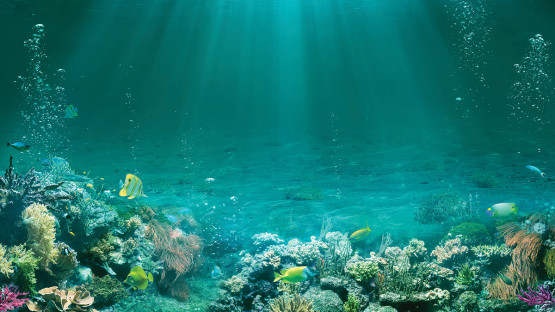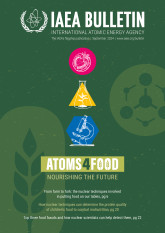
If you would like to learn more about the IAEA’s work, sign up for our weekly updates containing our most important news, multimedia and more.
How Nuclear Techniques Help ‘Blue Food’ Security
Ellie McDonald, Jana Friedrich, Marc Metian

The ocean is heavily affected by climate change, pollution and biodiversity loss. (Photo: AdobeStock)
(This article was originally published in the September 2024 IAEA Bulletin)
Since human beings came into existence, they have relied on the ocean as a source of sustenance. Today, more than three billion people depend on seafood and ocean products, also known as ‘blue food’. To ensure food security, these people need a supply of seafood that is healthy and safe to eat. However, the safety and sustainability of ocean-based food products are contingent on a healthy ocean and sustainable ocean management.
The ocean is heavily affected by climate change, pollution and biodiversity loss. Pollutants released from industrial and agricultural activities, ocean acidification resulting from excess carbon emissions, ocean warming and microplastic pollution place marine ecosystems under huge strain. Each of these stressors will have negative impacts on seafood safety and security; in combination, they can wreak havoc. Small island developing States (SIDS) are particularly at risk, as their economies are heavily dependent on the ocean for food security and employment. Furthermore, the ocean is fundamental to their cultures and way of life. The lack of resources and institutional capacity to address the threats posed by multiple stressors compounds this vulnerability.
To support countries, and SIDS in particular, in addressing coastal and marine pollution, the IAEA Marine Environment Laboratories in Monaco apply cutting-edge nuclear and isotopic techniques that allow countries to accurately monitor pollution, minimize the impact of polluting incidents and mitigate the effect of climate change on local populations. Using these techniques, the IAEA provides data on the potential impacts on ocean and human health and disseminates the knowledge necessary for the development of mitigation methods. The IAEA’s NUTEC Plastics initiative addresses the global challenge of plastic pollution on two fronts: at the point of source, by introducing new technologies to improve plastic recycling; and by identifying, tracing and monitoring plastics in the ocean, where the bulk of plastic waste ends up.
Nuclear technology complements conventional scientific techniques by assessing multiple stressors simultaneously — a key advantage for countries with reduced scientific capacity.
Understanding ocean stressors
When it comes to the impact of multiple ocean stressors on marine life, ecosystem function and overall ocean health, there are still many unknowns. Understanding the interplay between multiple stressors is crucial in order to effectively mitigate their negative effects. Only then will it be possible to support prevention, mitigation and adaptation strategies that can counteract them effectively.
Through its Ocean Acidification International Coordination Centre (OA-ICC), the IAEA coordinates collaborative research on ocean acidification and additional stressors. The OA-ICC enables the training of early career scientists entering the multiple stressor field to help them better understand key concepts and supports research in SIDS through various channels. “The OA-ICC and the IAEA are key in providing scientists in SIDS with the resources and capacity they need to study multiple stressors and the impacts they may have on their respective marine environments,” says Sam Dupont, a researcher at the University of Gothenburg in Sweden.
Additionally, the IAEA provides expertise on the pathways of potentially toxic chemicals. This enables scientists to study where heavy metals or radioisotopes from industrial, agricultural and municipal runoff end up, for example when they are released into rivers and groundwater and then into the ocean. In some instances, these toxins make their way to the sea floor, where they are ingested by bottom-feeding organisms such as clams and flat fish. IAEA scientists study how these toxins cycle through the marine food chain.
The IAEA conducts research on the biological impact of chemicals on certain species, and on how substances in organisms appear in increasing concentrations at the top of the food chain — a process called biomagnification.
“SIDS are particularly vulnerable to ocean changes and require greater attention and support to effectively address and mitigate the impacts of human activities,” says Florence Descroix-Comanducci, Director of the IAEA Marine Environment Laboratories. “Using nuclear isotopic tools and techniques, the IAEA Marine Environment Laboratories are providing critical support to study past ocean changes and the tools needed to address future impacts.”
More recently, the IAEA has developed laboratory approaches to focus on the impact of multiple stressors on blue food and provides support to scientists who lack access to nuclear and isotopic technologies in their countries. In this way, they can assess the impacts of multiple stressors on their national marine environment using nuclear technology, with the help of IAEA experts. For example, the IAEA Marine Environment Laboratories trains scientists in analytical methods including the use of radioligand receptor binding assays, a specific analytical procedure for identifying harmful algal blooms.
The IAEA hosts fellows from institutions around the world to enhance individual capacity and support the transfer of knowledge to home institutions.





